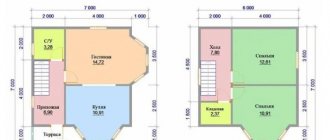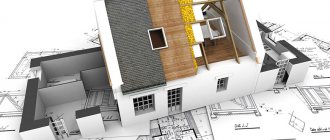For many people, a country house is something like a cherished dream - the prospect of taking a break from the bustle of the city in a cozy corner seems quite rosy. Moreover, you want not only to purchase a ready-made building with a landscaped garden plot, but to create the estate of your dreams, in which all your wishes regarding design and layout will be correctly embodied. There is only one thing left to do - transfer your ideas to paper, and only then, having drawn up a house project and determined its location on the site, bring it to life (engage in the actual construction of the house). If regarding the second point, by definition, there can be no doubt about the need for third-party help - even if you are a professional builder, you will not be able to build the right mansion yourself, but the costs of hiring an architect can be eliminated. How can design and construction be made cheaper? Yes, it’s very simple - it’s quite possible to do the work yourself, even without any special skills in creating a private house project. Designing a house (drawing it on paper schematically) is actually not that difficult!
What should you consider when designing your own home yourself?
The most important thing is that the house construction project you develop is created based on the following principles:
- Multiple functionality - that is, the house built according to this project will be convenient and practical in all respects. A do-it-yourself house design should be no worse than an architect’s;
- Simplicity of design - it will not be difficult to design a house only if it does not involve any frills. The creation of some particularly complex project, the implementation of which will require a huge amount of creative delights, is highly discouraged for a person who does not have a special education, because some fundamentally important things may not be taken into account;
- Aesthetics - of course, a country house should look beautiful and please the eyes of its owners. The design of a reliable house should also be spectacular!
Remember - if the project is created taking into account these principles, then it will be very good in life. Again, we are talking about a rather primitive independent structure - an amateur would not design a premium-class cottage. Only an architect should be involved in designing houses of this level - beginners here very often make mistakes.
Geological exploration of the house site
Where does “do-it-yourself home project work” begin? First of all, when working on a house project yourself, it is necessary to conduct a geological exploration of the site - assess the nature of the terrain, soil and find out the groundwater level. The best time of year for this is spring, then their level is as high as possible and it is possible to determine this indicator with maximum reliability. It is very important to do this based on the fact that this indicator is of greatest importance when laying the foundation of a private house.
To determine the depth of groundwater, we recommend contacting a specialist
I am newbie. Where can I learn to design?
The first option is to obtain a specialty at a university. Learning all the intricacies of the profession and spending 4-5 years studying is not the best option. It has its place, but it's not for everyone.
The second option is to study at special courses. It's simple. Enter a request into the Internet, choose a course and run. I won’t advise where exactly it’s better to study, but I know from experience that the level of teaching is the same everywhere.
The third option is to figure it out yourself. In the age of the Internet, it would be foolish not to use the tool of all freelancers. There are many lessons on YouTube, reference books and books, special forums.
How much time will I spend studying?
It took me 2 days to start drawing and a full month to learn all the nuances of the program. It all depends on you, if you are familiar with drawing, then the study will go quickly. To speed up your learning, draw the same drawing in different ways. This way, you will learn all the features of the program, and in the future this will help you greatly speed up the work process.
Design is taught in courses, but you can figure it out on your own.
Start designing a house
For a clear example, our editors used the free demo version of the Visicon program. But all the steps can be performed on a regular sheet of paper. For example, a simple project of a two-story house 10 m x 10 m was chosen
To design houses, you will need to “arm yourself” with an ordinary checkered notebook sheet and a pencil, while setting the appropriate scale. The most rational thing to do in this situation would be to do the following: ten meters of land should be designated by two squares. Thus, one centimeter on a ruler will equal 1 meter in real life - the ratio is one to one hundred.
Step 1: draw the outline of the house on a notebook sheet using a ruler and pencil on a scale of 1:100, i.e. 1 cm on paper is equal to 1 meter
Drawing on paper the outline of the site itself, as well as future buildings. In this case, all work must be carried out in strict accordance with the correct scale - by carefully measuring every meter on the ground and putting it on paper in accordance with dimensions one to a thousand, you ensure the reliability and aesthetics of the building being constructed. You can draw a project this way very quickly. It is imperative to take into account not only the contours of the site allocated for design and construction, but also all the objects located on the site that were there even before its planned construction, and at the same time there is no possibility of moving them. After this, it will be possible to begin designing the building itself - to simplify the task, we will assume that the designed house will consist of four rooms, a kitchen and two bathrooms (standard housing for a family of several people).
Skills, requirements and conditions for employment
For full-fledged professional activity as a designer, first of all, you need a completed higher education from any certified educational institution, as a rule, a construction department, with a profile in “Industrial and Civil Construction”. This is a basic education that allows you to start designing multi-apartment, private, industrial premises, as well as heat and water supply systems, ventilation and drainage systems for industrial and civil buildings.
A higher education in Industrial and Civil Engineering is required.
To carry out work on the development of gas and electricity supply systems, additional permitting documentation, preparation and status of the organization that carries out such work are already required. As with the development of documentation for residential premises (volume over 1500 m3 or above three floors), the organization requires SRO approval, the presence of a working group in accordance with the town planning code of the Russian Federation, namely, a senior engineer, an employee with at least 5 years of experience, an architect, two engineer and inspection official of the organization.
SRO approval is permission for an organization to carry out certain work. The requirements for the candidate are different everywhere, depending on the profile and scope of the tasks performed.
Employment in a state design organization
The first thing to divide the requirements into is the status of the organization - public or private. In the first case, the design unit is usually divided into departments. Each department is involved in the development of a certain part of the project documentation, there is a strict hierarchy of officials, and it is also clearly defined who is responsible for what, what volume they perform and to whom they report.
It is easier to get a job in a construction organization if you do an internship there during your studies.
Taking into account these parameters, it will be easier to get a job in such an organization, because in one of them, subject to studying at a state educational institution, you will undergo an internship, and subject to successful completion, even in the 2-3rd year you will be offered to continue your internship as a trainee or assistant engineer with subsequent transition to a full-time position upon completion of training and receipt of the coveted diploma.
First floor project
We draw the vestibule and the hallway on the sketch - and from there there will be transitions to the kitchen and other rooms. The location of the premises must take into account the following points:
- The bathroom and kitchen should be placed in close proximity to each other - thanks to this location it will be much easier to carry out communications;
- It’s very good if the drawn up project implies the absence of passage rooms - this is an integral element of comfort;
- On the ground floor, it is necessary to take into account the presence of all auxiliary structures and premises - their location will be very important not only to ensure the functional suitability of the house, but also for the comfortable movement of residents.
Step 2: draw all the rooms and premises of the first floor with the required size
After this, we arrange and plan all the doors of our house
Step 3: designing doors on the first floor
Then windows, taking into account the desired lighting of the rooms and your budget
Step 4: designing windows on the first floor
As a result, we get this first floor:
This is how the 3D model of the first floor turned out
I have been working as a designer for 4 years
My name is Trefilov Alexander Olegovich, I am 22 years old, and I am a design engineer by profession. I live and carry out my activities in the city of Kirov, Kirov region - this is just east of Nizhny Novgorod and west of Syktyvkar. I lead my career in the organization OCB-43 LLC, with a total work experience of about 7 years, as an engineer for about 4 years.
My profession from my perspective
Design engineer is one of the most sought-after specialties in the construction industry. Each manufacturing industry has its own designers, but everyone's background is different. The only thing they have in common is that they are all engaged in one task - the development of project documentation. It also includes partial preparation of estimates, performance of various physical and strength analyses, selection of materials, tooling and equipment.
House made of rounded logs
Regarding my profession, I am developing projects for private residential buildings made from coniferous forests: timber, rounded logs, laminated veneer lumber. The creation of preliminary, technical, design projects, as well as the development of design documentation for an industrial forestry workshop, in which semi-automated machines with CNC control carry out work on processing the main elements of the facility.
Drawing the second floor
Here everything will be much easier - after all, the rooms in the house can be located identically (the most important thing is not to change the relative position of the bathrooms - in order not to complicate communications). It will be enough to design the location of the front door (many architects recommend making two entrances to the second floor - at home and from the street) and windows.
Step 5: We plan the premises of the second floor in the same way. Don’t forget about communications - we place the bathrooms and bathrooms one below the other
Step 6: Place the Doors
Step 7: draw the second floor windows
We received this 3D model of the second floor
Level of customization offered by your builder
Manufacturers offer personalization across a wide spectrum, from almost custom to varied standard selections.
While options vary from builder to builder, buyers working with builders can usually choose their favorite colors and design styles (such as traditional or contemporary) across many key products used in the home. For example, you can choose styles and colors and/or good-better-better options in product categories such as these:
- Flooring
- Kitchen and Bathroom Countertops
- Kitchen and Bathroom Cabinets
- Internal and external doors
- Lighting fixtures
- Plumbing
- Hardware
- Technique
- Heating and air conditioning systems
- Paint and finishing
- External materials
This list may seem daunting, but remember that you have a support team in the form of your contractor and design center experts who can help you make sure your decisions work well with each other and with your chosen floor plan.
“There are two levels of choice when purchasing a new home ,” says Diana Morrison, national vice president of sales and marketing for Ryland Homes in Tampa, Florida. “When you first sign a contract, you need to make choices regarding design options, such as moving walls or changing locations or adding bonus rooms and extra baths. You'll then be able to select all finishes, such as flooring, cabinets, counters, lighting fixtures and hardware .
Depending on the builder, you may also be able to make structural changes to your chosen floor plan.
Attic and roof design
We decided to create a house project ourselves - there would be no need to try to draw some kind of too “abstruse” roof with a lot of bends. Remember - the roof is one of the most important structural components in the house, and trying to create additional aesthetics by questioning its reliability is certainly not worth it. All this will lead to leaks occurring at the bends. If you are drawing a project, please adhere to the principles of minimalism in architecture.
To design such a roof, you cannot do without an architect.
Dependency of designing a house with insulation
There is one very important rule - all auxiliary premises must be built on the north side. Despite the fact that thermal insulation performed using building materials is of paramount importance, the relative position of the rooms should also not be overlooked - if only because of the savings in energy consumption for heating the house.
Understanding Energy Efficient Features
New homes have many green features!
New homes are more energy efficient than homes of the past simply because new products and building technologies are available that help homes use less energy. At the same time, new homes must be built to meet the latest standards set by relevant documents, as well as buyer demand for energy-efficient features. While some builders specialize in building "passive houses", which are extremely airtight and largely heated by solar energy and "zero energy" homes, or design homes with extensive eco-friendly or "green" features, almost all residential builders have an energy package -efficient features that come standard in every home. And, depending on the builder, you can also add additional green features like solar panels, a tankless water heater, "We're used to explaining all the details and having a specific list of all the energy-efficient features, but research shows that buyers don't need to know the science of building , they just need to know that we build our homes with the latest technology,” says Katie James of Beazer Homes. “People basically want to know if they're buying energy-efficient homes because it's something they've heard about. They just want to know how much their utilities will cost. We test each home to show how much they will save.”
As a benefit to their customers, some contractors offer a program that details the company's green building practices and the energy efficiency of its homes. The “What Home Buyers Really Want” survey found that 94 percent of new home buyers want energy-efficient appliances, 91 percent want Energy Star ratings for the entire home, and 89 percent want Energy-Star rated windows.
“People want energy-efficient windows and appliances because they know their utility bills should be low and because they know they work well,” says Stephen Mehlman. “Energy efficiency is important as long as people feel they don't have to pay a lot for it. They're willing to spend a little more on a tankless water heater, but once you get into the $5,000 to $10,000 range, people are less likely to spend the extra money. Things like an expensive solar roof are less popular, but energy-efficient heating and air conditioning systems are standard in new homes.”
Approval of the project to begin construction
The need to adjust the project. Even if you yourself were able to depict the house of your dreams on paper, you will still need to consult with specialists before starting construction of the house - the opinion of a competent foreman or architect will not be superfluous. At a minimum, the following points will need to be agreed upon:
- Carrying out electrical work;
- Conducting your own sewerage system;
- Carrying out water supply;
It is necessary to understand that all the above issues are not an artistic or architectural part of the project. These are all the most routine issues, a competent approach to solving which is provided only by professionals in their field. As a last resort, any oversight in independently drawing up a house project, which was made by a person who does not have a specialized education, can be corrected by a competent foreman who understands the practical side of any idea much better. Although even if the project is drawn up by professional architects, purely practical shortcomings cannot be ruled out.
Independent work on a house project and its advantages
You can create the design of your house yourself - in order to develop drawings of the relative position of certain rooms, as well as determine the place of the house on the site, you do not need special knowledge. A competent and responsible approach to business will ensure the success of your event. However, in terms of communications, it will be necessary to consult with professionals. This way you can properly plan a house that will serve you faithfully.
Read about the following stages of construction:
Types of foundations used in construction
Which is better to choose a foundation for the soil and type of house
Water supply for a private home
Watch also the video on how to make a house project yourself
Read about the previous stages of construction:
Layout of land for building a house
Why would it be beneficial for me to design rather than engage in another type of freelancing?
You are free to do whatever you want. Not everyone likes designing. This is a job that requires care and responsibility. This is why design pays well.
The average salary for designers is 45,000 in Moscow. By spending a couple of days drawing projects, you can accumulate a large sum, it all depends on you.
Customers who demand to do a lot and pay little are a meager number when compared with other types of freelancing. There is a work!
My allowance
The salary is very ambiguous, depending both on the region and on the status of the organization itself. On average in the regions the amount is around 35,000 rubles per month, in the capital it is higher, but the requirements are also relative. In government organizations the level is lower, but there is a full social package, regulations on work and rest time. In a private organization, you have to work piecework and with an irregular work schedule.
My salary depends on the volume of work of the workshop and the working group.
There is no salary as such, vacation and weekends too. For 1 m3 of log house, which went from design to assembly, I will receive 0.3%, which is about 270 rubles. Or about 33,000 rubles for a house with a volume of 250 m3, which in the volume of a log house is equal to about 120 m3 of lumber, for a period of about 3 months.
On average, I have about 55,000 rubles a month, taking into account the current financial situation in our country and the decline in the volume of work over the past 3 years.
Registration according to the Labor Code, where the salary costs 25,000, and a pension comes from it. There are no other social guarantees.
Features of the profession of a design engineer
the main advantages of my profession to be:
- the ability to design, create, invent, think creatively and turn it into a real building;
- the ability to perform the work of both an engineer and an architect;
- free schedule;
- the possibility of partially determining the volume of work for a month;
- the opportunity to gain experience communicating with successful people, because most clients have very large incomes, and you can get a lot of interesting information from them.
The profession is quite authoritative and necessary, in which there is no limit to perfection, and there is a direction in which to continue studying and training.
But again, working with a private contingent is as much a minus as a plus, because people are different, and not everyone can find a common language and explain that there is certain legislation, norms and standards that we are obliged to adhere to, for this reason the reason why refusals occur.
Hierarchy of positions in a design organization
The hierarchy in a private organization of officials is different everywhere, but, as a rule, there are:
- senior engineer - head of the design department,
- architects,
- estimators,
- ordinary engineers,
- sometimes cadastral engineers , if the organization is additionally involved in working with land plots.
Career growth is possible, but you have to try.
First of all, for promotion you will need a vacant or vacant position, a good reputation, an understanding of all processes in the department and the potential opportunity to work in such a position. In short, you must show promise that you can accomplish those tasks and more, producing only positive results, despite the difficulty of the task.
Also read: Mechanical Engineering Careers - From Draftsman to Design Engineer











